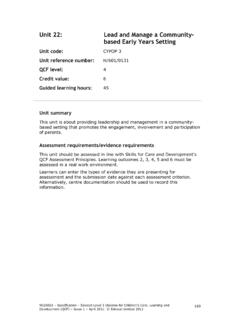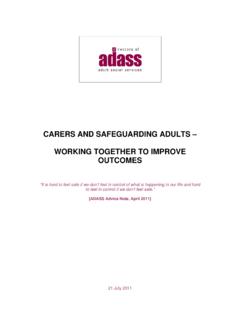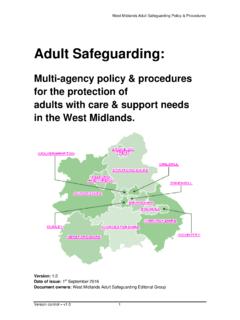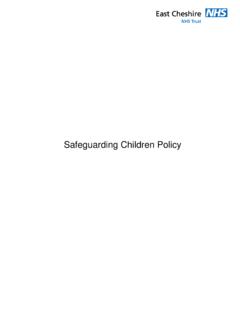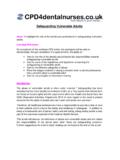Transcription of UNIT 4: PRINCIPLES OF SAFEGUARDING AND …
1 UNIT 4: PRINCIPLES OF SAFEGUARDING AND protection IN health AND SOCIAL CARE. Unit 4: PRINCIPLES of SAFEGUARDING and protection in health and social care Unit code: A/601/8574. QCF Level 2: BTEC Specialist Credit value: 3. Guided learning hours: 26. Unit aim This unit is aimed at those working in a wide range of settings. This unit introduces the important area of SAFEGUARDING individuals from abuse. It identifies different types of abuse, and the signs and symptoms that might indicate abuse is occurring. It considers when individuals might be particularly vulnerable to abuse and what a learner must do if abuse is suspected or alleged. Unit introduction This unit will enable learners to recognise the importance of SAFEGUARDING when working in health and social care. Learners will investigate types of abuse and the signs and symptoms which may indicate these. Learners will also examine the factors that may contribute to vulnerability in individuals. The unit examines actions to take in cases of suspected and alleged abuse and the national policies and local systems which are part of the SAFEGUARDING framework.
2 The roles of various relevant agencies are considered, together with sources of information and advice about the learner's own role. Serious incidents and high profile cases are considered as examples of failure to protect individuals from abuse, together with unsafe practices which may affect the wellbeing of individuals who use the services. Learners will also consider those practices which may reduce the likelihood of abuse occurring. Learning outcomes and assessment criteria In order to pass this unit, the evidence that the learner presents for assessment needs to demonstrate that they can meet all the learning outcomes for the unit. The assessment criteria determine the standard required to achieve the unit. BA029952 Specification Edexcel BTEC Level 2 Certificate in Preparing to Work in Adult Social 43. Care (QCF) and Level 3 Certificate in Preparing to Work in Adult Social Care (QCF) . Issue 2 December 2011 Pearson Education Limited 2011. UNIT 4: PRINCIPLES OF SAFEGUARDING AND protection IN health AND SOCIAL CARE.
3 On completion of this unit a learner should: Learning outcomes Assessment criteria 1 Know how to recognise signs of Define the following types of abuse abuse: physical abuse sexual abuse emotional/psychological abuse financial abuse institutional abuse self-neglect neglect by others Identify the signs and/or symptoms associated with each type of abuse Describe factors that may contribute to an individual being more vulnerable to abuse 2 Know how to respond to suspected Explain the actions to take if or alleged abuse there are suspicions that an individual is being abused Explain the actions to take if an individual alleges that they are being abused Identify ways to ensure that evidence of abuse is preserved 3 Understand the national and local Identify national policies and local context of SAFEGUARDING and systems that relate to protection from abuse SAFEGUARDING and protection from abuse Explain the roles of different agencies in SAFEGUARDING and protecting individuals from abuse Identify reports into serious failures to protect individuals from abuse Identify sources of information and advice about own role in SAFEGUARDING and
4 Protecting individuals from abuse 44 BA029952 Specification Edexcel BTEC Level 2 Certificate in Preparing to Work in Adult Social Care (QCF) and Level 3 Certificate in Preparing to Work in Adult Social Care (QCF). Issue 2 December 2011 Pearson Education Limited 2011. UNIT 4: PRINCIPLES OF SAFEGUARDING AND protection IN health AND SOCIAL CARE. Learning outcomes Assessment criteria 4 Understand ways to reduce the Explain how the likelihood of likelihood of abuse abuse may be reduced by: working with person-centred values encouraging active participation promoting choice and rights Explain the importance of an accessible complaints procedure for reducing the likelihood of abuse 5 Know how to recognise and report Describe unsafe practices that unsafe practices may affect the wellbeing of individuals Explain the actions to take if unsafe practices have been identified Describe the action to take if suspected abuse or unsafe practices have been reported but nothing has been done in response BA029952 Specification Edexcel BTEC Level 2 Certificate in Preparing to Work in Adult Social 45.
5 Care (QCF) and Level 3 Certificate in Preparing to Work in Adult Social Care (QCF) . Issue 2 December 2011 Pearson Education Limited 2011. UNIT 4: PRINCIPLES OF SAFEGUARDING AND protection IN health AND SOCIAL CARE. Unit content 1 Know how to recognise signs of abuse Types of abuse: physical abuse (eg hitting, shaking, biting, throwing, burning or scalding, suffocating, force-feeding) or otherwise causing physical harm to an individual; sexual abuse (eg forcing an individual to take part in sexual activities or behave in sexually inappropriate ways, penetrative acts including rape or buggery and non-penetrative acts, watching sexual activities, including viewing inappropriate sexual activity on the internet); emotional abuse (eg bullying, invoking threats or fear, devaluing individual self-esteem, verbal abuse and swearing, imposing inappropriate expectations, conveying feelings of worthlessness, exploitation); financial abuse (eg theft of money or property, misappropriation or mismanagement of individuals' finances, denying individuals access to their own finances, particularly with the elderly or individuals with learning difficulties).
6 Institutional abuse (eg misuse of authority, information or power over vulnerable individuals by staff in health and social care settings, failure to maintain professional boundaries, inappropriate use of medication, physical restraint, humiliation or bullying, denying privacy); self-neglect (eg individuals engaging in neglectful or self-harming behaviours including refusing to eat or drink, neglecting personal hygiene or toilet needs, causing actual bodily harm to self including cutting); neglect by others (eg not caring for the basic needs of individuals including neglectful practice in washing, toileting, feeding or personal care). Signs and symptoms of abuse: physical abuse (eg bruising, bite marks, burn marks, changes in behaviour, can lead to death in extreme cases); sexual abuse (eg disturbed behaviour including self-harm, inappropriate sexualised behaviour, repeated urinary infections, depression, loss of self-esteem, impaired ability to form relationships); emotional abuse (eg loss of self-esteem and self- confidence, withdrawn); financial abuse (eg loss of trust, insecurity, fearful, withdrawn, conforming or submissive behaviour, disappearance of possessions, power of attorney obtained when individual is unable to comprehend).
7 Institutional abuse (eg loss of self-esteem and confidence, submissive behaviour, loss of control); self-neglect or neglect by others (eg unkempt appearance, weight loss, dehydration, signs of actual self-harm including cuts, withdrawn or submissive behaviour). Factors contributing to vulnerability: age (eg elderly, young children); physical ability (eg frail, immature development, physical disability or sensory impairment); cognitive ability (eg maturity, level of education and intellectual understanding, learning difficulties); emotional resilience (eg mental health difficulties, depression); stress (eg impact of stressful life events including bereavement, divorce, illness or injury); culture or religion (eg as a result of prejudice or discrimination, refugees and asylum seekers); socio-economic factors (eg financial situation). 2 Know how to respond to suspected or alleged abuse Actions to take regarding suspicions or allegations of abuse: including actions to take if the allegation or suspicion implicates any individual, a colleague, self or others; understanding roles and responsibilities; importance of following legislation, policies, procedures and agreed ways of working; basic information includes who the alleged victim is, who the alleged abuser is, categories of 46 BA029952 Specification Edexcel BTEC Level 2 Certificate in Preparing to Work in Adult Social Care (QCF) and Level 3 Certificate in Preparing to Work in Adult Social Care (QCF).
8 Issue 2 December 2011 Pearson Education Limited 2011. UNIT 4: PRINCIPLES OF SAFEGUARDING AND protection IN health AND SOCIAL CARE. abuse that could be happening, when abuse has happened, where abuse has happened; importance of treating all allegations or suspicions seriously; lines of communication and reporting; reporting suspicions or allegations to appropriate/named person; importance of clear verbal and accurate written reports; importance of not asking leading questions with individuals concerned;. importance of respectful listening; confidentiality and agreed procedures for sharing information on disclosure; importance of actual evidence and avoiding hearsay Ensure evidence is preserved: use of written reports (including details of alleged/suspected abuse, signed, dated and witnessed); use of witness statements (signed and dated); photographic evidence (eg of physical injuries);. agreed procedures for using electronic records (eg password-protected systems); confidential systems for manual records (eg security systems, access to evidence records); importance of timescales to ensure reliability and validity of evidence; secure storage of any actual evidence (eg financial records).
9 3 Understand the national and local context of SAFEGUARDING and protection from abuse National policies and local systems: national policies including the scope of responsibility of the Independent SAFEGUARDING Authority (ISA); the national Vetting and Barring Scheme (VBS); Criminal Records Bureau (CRB) checks; No Secrets' national framework and codes of practice for health and social care (2000); SAFEGUARDING Adults' national policy review (2009); work of the Care Quality Commission; Working Together to Safeguard Children' (2006); Every Child Matters' (2003); Common Assessment Framework (CAF); local systems including the scope of responsibility of Local SAFEGUARDING Children's Boards (LSCBs), Local SAFEGUARDING Adults Boards (LSABs) and protection committees;. Local Area Agreements (LAAs). Role of different agencies: importance of multi-agency and inter-agency working; social services (eg social workers, care assistants, residential children's home workers); health services (eg GPs, nurses, occupational therapists, health visitors); voluntary services (eg MIND, NSPCC, Age UK); the police.
10 Responsibilities for allocating a named person (usually from statutory agencies in health or social care); responsibilities for overseeing the SAFEGUARDING assessment and its outcome; consulting the police regarding all SAFEGUARDING incidents; convening or chairing strategy meetings, including the agreement of responsibilities, (lead professional); actions and timescales; coordinating and monitoring investigations; overseeing the convening of SAFEGUARDING case conferences; providing information about activities and outcomes to the SAFEGUARDING Coordinator Reports on serious failures: serious case reviews on the abuse of children, young people and vulnerable adults, including eg the Laming report into the death of Victoria Climbi (2000); Haringey Council report on the death of Baby Peter (2007); Bedfordshire Council report into the torture and death of Michael Gilbert (Blue Lagoon murder, 2009); Birmingham social services review into the starvation and death of Khyra Ishaq (2010). Sources of information and advice about own role: current and relevant sources of information from websites, leaflets, organisations, local and voluntary groups including government sources (eg DfE, DoH); voluntary organisations (eg NSPCC, Barnard's, the Ann Craft Trust); publications eg Working Together to Safeguard Children' (2006), What to do if you suspect a child is being abused'.









